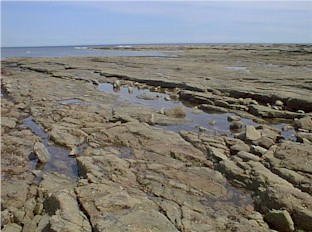If you're visiting Staithes as either an amateur or professional Geologist, or just to walk along the rocks, then there are a few things that you must take seriously even though you may be on holiday. We wish that your visit to Staithes is a memorable one, but for all the right reasons.

An animation of a person in the water waving for help
Image by Animation Factory
The area of foreshore at the base of the cliffs is what is known as a wave cut platform. By its nature it is generally flat and extends a considerable distance out to sea.
This platform has been eroded from the cliffs by the power of the waves and consequently, at high tide, the sea returns VERY QUICKLY right up to the base of the near vertical cliffs. If you or your children are caught on the foreshore at the return of the tide you will find there is no where to take refuge. The only way off, if you are lucky, is by being rescued by the RNLI Lifeboat.
Do not take risks. Get a copy of the local tide tables from the Post Office or many of the other stores in Staithes and only venture out onto the foreshore on a falling tide. Once the tide turns make your return to the safety of the harbour and town. If you cannot find a set of Tide Tables most of the local pubs keep one handy.

Wave cut platform of the Lower Lias at Staithes
Image by John Vincent dated: July, 2004
Wear sensible shoes or better still proper hiking, climbing or walking boots. Flip flops or trainers are useless for this purpose. The exposed rocks are quite easy to walk on whilst they are dry but even a small shower can change all that turning your path into a veritable ice-rink.
Large areas of exposed rock are covered with seaweed or algae either way they to will be extremely slippery and may have creepy-crawlies under them.

An animation of a crab in the rock pools at Staithes
Image by Animation Factory
The cliffs around Staithes are made up of loose sandstones, clays and shale. They are VERY unstable and no attempt what-so-ever should be made to climb them. The cliffs of Cow Bar Nab are protected by the National Trust and the cliff to the south of the town are part of a SSSI and are protected by law.
The removal of fossils, or anything else for that matter, from the cliff face is an offence. Keep your fossil hunting to to the fallen rocks and the foreshore.
If you sit or stand for a while in the vicinity of the cliffs you will hear the sound of falling rocks and pebbles. Erosion from the cliff face is an almost continuous process with small quantities of rubble falling all the time. If you look along the base of the cliff you will see boulders the size of your car, please remember they used to be high up the cliff and they are now on the beach. Make sure you and your children are not underneath the next one that falls.
In order to get at many of the fossils you will need a hammer but before you start banging away at the rocks beware that they will often shatter sending rock splinter in all directions. Take precautions for yourself and wear goggles or safety glasses (Sun glasses will not do as they can break and make your situation a lot worse) AND take care for those around you, ask spectators and your colleagues to move away to a safe distance. Remember it is illegal, and extremely dangerous, to remove rocks or fossils from the cliff face.